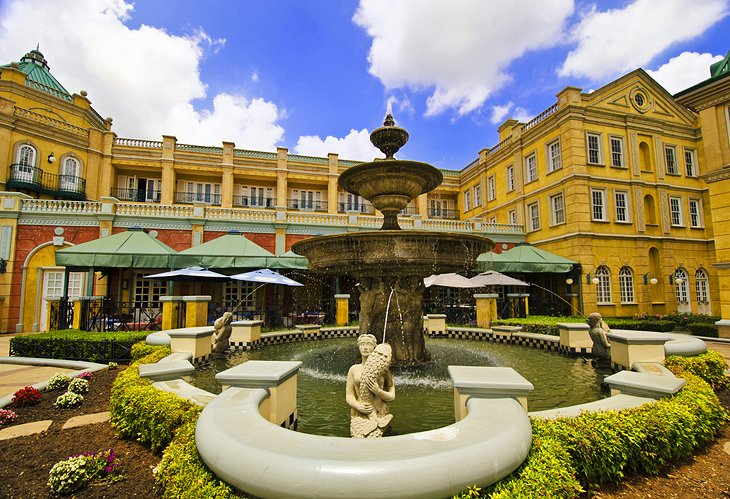Johannesburg North Attractions Things To Know Before You Get This
Johannesburg North Attractions Things To Know Before You Get This
Blog Article
Johannesburg North Attractions - Truths
Table of ContentsThe Johannesburg North Attractions IdeasJohannesburg North Attractions - TruthsThings about Johannesburg North AttractionsFascination About Johannesburg North AttractionsAll About Johannesburg North AttractionsOur Johannesburg North Attractions Diaries
The city grew on the side of the Witwatersrand Main Reef, a subterranean stratum of gold-bearing quartz-silica empire that arcs for hundreds of miles underneath the Highveld - Johannesburg North attractions. Most of the gold mines in the city discontinued operation in the 1970s, yet in its day the Witwatersrand gold sector accounted for more than 40 percent of the globe's annual gold manufacturing.Johannesburg has a temperate climate. Summertime temperature levels balance concerning 75 F (24 C); winter months temperatures balance concerning 55 F (13 C) and just occasionally dip listed below freezing. The city delights in concerning eight hours of sunshine each day in both winter and summer season. Rain averages concerning 28 inches (700 millimetres) per annum, however the total varies substantially from year to year.
What rainfall the city gets drops almost solely in the summer season, often in spectacular late-afternoon electrical tornados. Air pollution positions a substantial issue, particularly in the winter season, when thermal inversions hamper the westward flow of air from the Indian Ocean. Contamination is most serious in the largely worked out Black municipalities on the city's perimeter, where many locals still count on coal for gas.

How Johannesburg North Attractions can Save You Time, Stress, and Money.
The equilibrium of the city is occupied by whites. Lodging varies in character and top quality. Soweto is well-known for its unlimited rows of municipally constructed, two-room matchbox homes, yet it also has a few thriving territories as well as bursting squatter camps, where 10s of thousands live without water, electrical energy, or sanitation facilities.
Physical growth, although rather restricted by transport, proceeded quickly as migration to South Africa, and Johannesburg specifically, increased significantly. This issue was addressed in the 1930s when the automobile was presented in mass production to South Africa. Cars were, generally, restricted to the well-off, and allowed them to relocate to the north of the city and commute right into the centre.
Many poor suburbs were combined, with bad blacks and whites living with each other, although the well-off suburban areas were typically booked for whites.
The previous system of eleven numbered regions was reorganised in 2006. Marshalltown, as seen from the top of the Carlton Centre. The M1 and M2 run behind the structures, and the southern residential areas prolong past the highway border. The inner city of Johannesburg is situated within the city's Region F. The approximated populace of the region is 200,000, [] The number of individuals living in the internal city on an informal basis is unidentified, as many are unlawful immigrants. Most higher-income homeowners and white people have relocated to the northern suburban areas and have actually been replaced by lower-income black individuals. The unemployment, education, and age accounts of the area are all unknown, as a result of the difficulty of acquiring reputable details regarding the area.
Some Known Factual Statements About Johannesburg North Attractions
Yeoville and Bellevue have a mix of apartment and single domestic devices on tiny great deals. The area is situated on a mountainous divide that runs from east to west. One of the most obvious geographical function is Observatory Ridge, which is named for the huge observatory situated on it. The leisure rooms are no much longer used, due to security problems.

Johannesburg Arena, a training ground for link both the Golden Lions and Orlando Pirates, is adjacent. The eastern suburbs of Johannesburg lie in the city's 7th [] and 9th [] regions. The location is also functionally incorporated with East Rand border communities beyond the main limit of Johannesburg, such as Bedfordview and Edenvale (both part of Ekurhuleni Metropolitan Community).
Facts About Johannesburg North Attractions Revealed
The eastern suburban areas are some of the oldest areas of Johannesburg, there are huge communities of Jewish and various other European backgrounds, the bulk of the population is English talking. There are three golf courses as well as a number of secured ridges with viewsites.
The area is mostly made up of old "matchbox" houses, or four-room residences constructed by the government, visit this site right here that were constructed to supply cheap holiday accommodation for black workers throughout discrimination. Soweto is an abbreviation, meaning "South Western Townships". Street after road around is lined with matchboxes; however, there are a few smaller sized areas where thriving Sowetans have constructed residences that are more comparable in stature with those in even more upscale suburbs.
Hostels are one more prominent physical feature of Soweto. Initially constructed to house male migrant workers, several have actually been enhanced as houses for couples and households. The N1 Western Bypass skirts the eastern limit of Soweto. The residential area was not historically permitted to create work centres within the location, so nearly all of its locals are travelers to other components of the city.
The 7-Second Trick For Johannesburg North Attractions
The N1 Western Bypass connects the northern suburbs with the north-western suburban areas. The houses in the northern suburban areas are generally formal, with no substantial areas of informal housing, or housing that lacks an irreversible structure. Although this is a well-known area, there is a pattern of land use adjustment from domestic to business, especially along main arterial roadways and around well-known nodes.
Roadways to go to website the east and west are less well created, as there are no freeways taking a trip in that instructions. Towards the north border of the city, the thickness of development decreases, leaving large locations of undeveloped land around Midrand.
9 Simple Techniques For Johannesburg North Attractions
, which is situated on a hill overlooking the internal city and Hillbrow.
Report this page